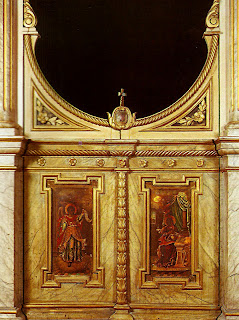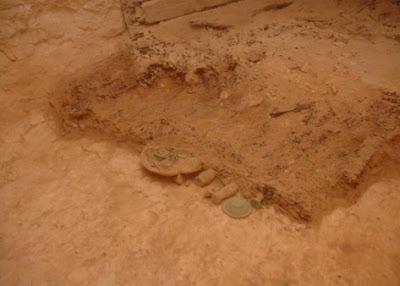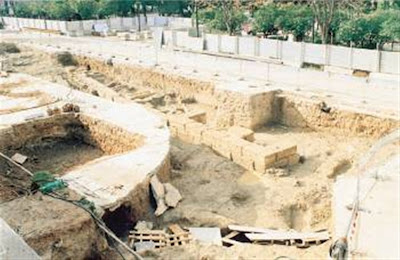Alexandria: Beacon of Orthodoxy and Hellenism http://hellasfrappe.blogspot.co.uk/2012 ... tolic.html
The glorious history of the Apostolic Throne of Alexandria, of a duration of two thousand years, has made it a beacon in the field of theology, learning, church affairs and culture, and above all has maintained its high reputation and honour to the glory of the entire Eastern Orthodox Church. From the founding of the Church of Alexandria by Saint Mark the Evangelist down to our own times, the Patriarchate has occupied a sui generis and pioneering position in universal Orthodoxy. The names of many Popes and Archbishops of Alexandria are commemorated in the West as well as the East, since their lives, their work and their teaching have rendered invaluable services and they have served as outstanding leaders of the Church of Christ.
This has been and this remains the mission of our Greek Church and naturally, of the Patriarchate of Alexandria - a sacred and most important mission. There is nothing enclosed or secret about it. It comes out of its own enclosed space and environment and extends into every place. For centuries it has served so many different communities along with the Greek diaspora, the Arabs and the Africans, insofar as local conditions, times and circumstances allow. Thus the Church of Saint Mark has provided the Greek far from his place of origin with manna and water in the wilderness at times which have been difficult and sometimes tragic. This living presence and practical help of the Patriarchate of Alexandria have kept the Greeks firmly and lovingly linked with their origins and have endowed them with pride which teaches that it is only through maintaining their national identity that the Greek nation will live and achieve great things. This mission has been fulfilled only through the self-sacrifice and toil of so many saintly and holy Patriarchs of Alexandria.
Just as the Greeks of Egypt for so many years, and under the most unfavourable circumstances, have felt bound by their historic traditions and have fulfilled their duty to the full, so today they are called upon to stand with awe and awareness before the remaining relics of the ark of history and the renown of their ancestors- which live on and serve to teach and set examples - and to honour them.
The Church of Alexandria, which has always advanced hand-in-hand with the Greek community of Egypt, has never confined its interest to the spiritual benefit of its faithful children, but has been concerned to safeguard down the ages its cultural and historic past. By its work for society, for charities, for the nation, for education, it has set up, especially here in Egypt, monuments of historic worth, dignity and civilizing influence. This achievement through the course of history has remained dynamic and imperishable down to our own times. It continues precisely in order to bear its perpetual witness to a history and presence in a Greek Orthodox patriarchate and a Greek Community which go forward together so that the achievements and the course of renewal of two thousand years may be continued.
Makarios Tillyridis, PhD
Metropolitan of Zimbabwe

There is no question that, from the time of its building (332-331 BC), on the inspiration of Alexander the Great himself, by the famous architects Donocrates of Rhodes and Cleomenes of Naucratis, the great city of Alexandria became a unique center for the world of the time, with great prestige in intellectual, economic, cultural, commercial and military life. Because of its geographical position, the city of Alexandria also became a centre which linked ancient Egyptian civilization with that of Greece and Rome, and then with that of the Jews, to emerge as a renowned capital which was a meeting-point for the main spiritual and intellectual trends of that time. Its famous libraries and other important centers of letters and the arts, such as its university, were forerunners which were to have positive effects when Christianity subsequently made its appearance.
According to experts, Alexandria in ancient times also held a primary place because of its libraries. As early as the time of Alexander the Great, large numbers of men of letters and other tried and tested experts were summoned to the city in order to create suitable conditions for the valuable manuscripts of ancient Greece. There is not much information about this subject left to us but what is certain, however, is that the successors of Alexander, the Ptolemies, and particularly Ptolemy Lagus, wishing to make Alexandria a centre of civilization, education and the arts, summoned men most renowned for wisdom and arts. It was Ptolemy Lagus - also called Soter - who laid the foundation stone of the Museum library. Reliable sources tell us that Ptolemy Soter founded not only the Museum, but also the Library - the Great Library - of Alexandria. This is believed to have been the richest and largest in the ancient world. Yet another library was set in parallel with this, next to the temple of Serapis. Together they contained all the wealth of the manuscripts of the times, and so could claim the title of universal library.
Tradition tells us that the first Christian church to be built in Egypt was that of the Mother of God, near the habour of Alexandria, on the very spot where the Apostle and Evangelist Saint Mark was martyred. This magnificent church was built at the time when Saint Theonas was Patriarch of Alexandria (282-300). With the spread of Christianity, churches of great beauty - and monasteries - rapidly sprang up in Egypt. It is said that around Alexandria itself there were about a hundred monasteries, fifty at Mariotis (Mariut), and many more in the desert. However, two splendid churches were the special boast of the Patriarchate of Alexandria: the Kaisareion and the Serapeion. The former was built by Cleopatra, Queen of Egypt, as heröon. It was later, in the time of Constantine the Great, consecrated as a church, dedicated to the Archangel Michael. This was the Great church of Alexandria. The Sarapeion was originally a pegan temple of the Ptolemies, but became the church of Saint John, since it housed the relics of the saint. The Monastery of Saint Sabbas during its long history was used not only as a dwelling-place for monks, but also as a cemetery, a hospital, a school, a hostel, and a public health centre. Above all, however, the Monastery of Saint Sabbas served as a centre for the Patriarchal Throne of Alexandria.

Alexandria, as the seat of the second most senior Greek Orthodox Patriarchate, continued to be a centre for literature and the Greek Christian arts. This glorious tradition of Alexandrian history has been carried on by the Library of the Patriarchate of Alexandria, which for most of the two millennia has radiated its enlightenment to the world. The history of the Patriarchal Library, which always seems like a continuation of the Library of the Ptolemies, today attracts the interest of many researchers and historians, since it houses valuable manuscripts and rare books with an all-embracing orientation.
Among the famous schools of Alexandria, the Catechetical School was always the pride and joy of the Church of Saint Mark. It would be no exaggeration to say that this School was seen not only as the boast of the Church of Alexandria, but as encapsulating the thought and experience of Christianity as a whole. Also of importance was the contribution of the School to the theological thought and practice of Alexandria. Those who taught at this renowned centre of education, influenced by ancient Greek philosophy, proved able to introduce a new tendency in the merging of it with Christianity, and this was the culmination of the success of the work of the Catechetical School. It is a fact of history that the spring of the School was characterized by its quality, sublimity and its revelatory nature.
Difficult times, were, however, in store for the patriarchate. The 7th century was the most terrible in its history. With the Arab conquest, the Patriarchate of Alexandria passed through a vale of tears. Persecution, quarrels between opposing camps, poverty, deprivation, the interruption of life in all its forms were the results. The distress endured by the Patriarchate prevented it from making any progress. Innumerable monasteries and churches were destroyed. Many centres of great historical and religious importance were converted into Muslim mosques and lost for ever to Christianity. Hundreds of bishops and bishoprics were wiped out, Greek Christians were slaughtered in their thousands, manuscripts and monuments of inestimable value disappeared. For eighty- five years the Church of Alexandria remained without a head. But among the ruins and the destruction the flame of faith was never wholly extinguished.
There have been periods of brilliance and glory in the history, spanning nearly two thousand years, of the Patriarchate of Alexandria - times when the city has produced great Fathers of its Church, figures such as Origen, Clement, Pantaenus, Athanasius the Great, Dionysius, Heraclas, and Didymus. Schools of great renown and breadth of Spirit were set up on the inspiration and under the protection of successive Bishops of Alexandria. These holy fathers, their thought clothed in ancient Greek and Christian wisdom, founded centres which replaced the ancient temples of the philosophers and the gods, in order to bring generous enlightenment to the young. Thus they were succeeded by figures who were unrivalled continuators and matchless practitioners of the experience of the brilliant progression of Alexandrian thought and life.

The constant increase of the Greek ethnic element in the land of the Nile called for the building of a church of some grandeur to meet their religious needs, but also to serve as a meeting- place. Patriarch Ierotheos, a dynamic figure in the Greek world of the 19th century, prompted by distinguished Greeks of Alexandria, decided to undertake the task of the construction of a church dedicated to the Annunciation of the Blessed Virgin Mary.
Thus, Alexandria acquired yet another monument witnessing to the labours of the patriotic and devout benefactors, who set up a monument worthy of the history and culture of the Greek immigrants. The Greeks of today look with pride upon the determination and greatness of their ancestors who have left them such a glorious heritage. From that time on, the church of the Annunciation of the Theotokos has been the chief pride of the Greeks of Egypt.
The 19th century could be described as the golden age of the Greek presence in Alexandria. The Greeks who began to settle in the city were men of education, chiefly involved in the world of commerce. By their industriousness and unrivalled zeal they succeeded in exalting the name of Greece to heights it deserves to occupy and in carrying through projects which are still an adornment to Egypt and call forth the admiration of the Egyptians and foreigners alike. Wherever they passed they left behind them historic achievements of importance in the fields of culture, agriculture, education... The setting up of educational and cultural institutions and distinguished benefactors such as Georgios Averof helped Alexandria and its Patriarchate to experience days of great glory and repute. It was at that time that other Greek communities were established, the number of charitable institutions increased, the first Greek newspapers circulated, and Greek books - the bibliography is impressive - were published.
It was, the, in the city of Alexandria that the Greeks of Egypt set up schools, hospitals, orphanages, chambers of industry, clubs, sports associations, cultural societies etc. - all this with the help and blessing of the renowned and historic Patriarchate of Alexandria - whose jurisdiction nowadays extends to the whole of Africa. It was only to be expected that there, where the Greeks formulated new and lofty objectives, they should encounter problems and difficulties, which, of course, continue to be the case today. Their spiritual leader is the Patriarch himself.

From the time of its foundation, the church of Alexandria occupied a leading position among the other Christian Churches, and indeed came to be regarded as holding first place. Thus the renown Thrown of Saint Mark enjoyed many honours. This marriage of the Greek and Christian spirit helped Alexandria to outshine Athens and meant that this period of its great prosperity come to be regarded as the golden age of great and ancient Greece.
Thus the Church of Alexandria from then until the present day has kept alive the fame and a beacon - a latter-day Pharos - visible a great way off for the Orthodox Christians of the African continent of every race and colour.
Today, the Patriarchate of Alexandria is called upon to continue along the path of its history, even if with only a few remaining Greeks and Greek Orthodox Christian Arabs, though with many Orthodox peoples of Africa it must continue to be a factor for progress and improvement.
At present, it must emerge from the ruins again and become a new Pharos for the Greek nation's advance with high-value projects in the educational, apostolic and cultural domain. The new Patriarch of Alexandria is in a position to bring again days of glory and renown. Such renewal will help to raise its prestige and advance its mission in the world of today.
Source: Alexandria: Beacon of Orthodoxy and Hellenism
NOCTOC:-
http://noctoc-noctoc.blogspot.co.uk/201 ... y-and.html














